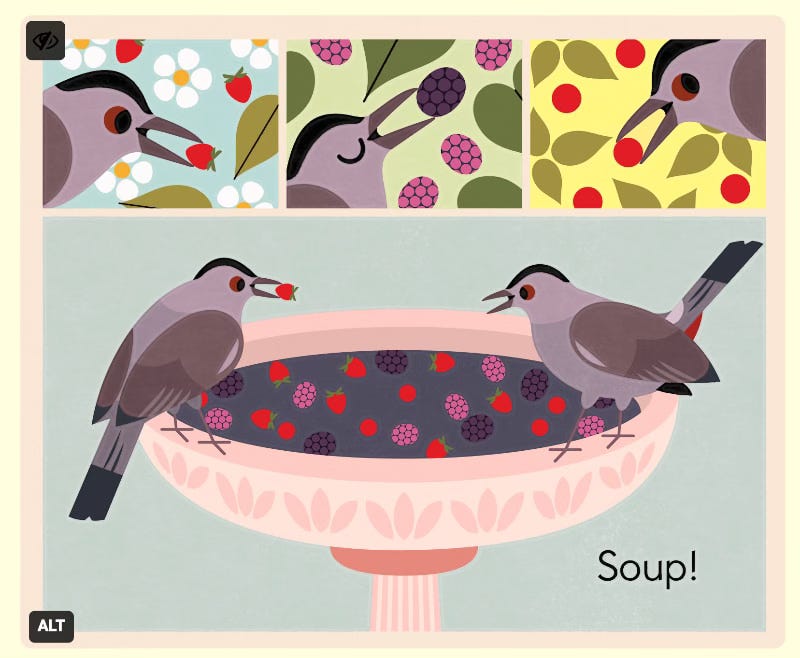
Starting with a “Good morning Everyone” from a corner of the mead. The best time of the day to be outside …
Melissa Harrison ( a fine English nature writer) slipped this message into a recent Substack of hers …
I wrote about counting in all my most precious birds, like the cuckoo, the local nightingales and our village swifts, and about our duty – yes, duty, I think, these days – to turn our gardens into insect incubators, while there’s still time to reverse the galloping loss of invertebrates happening on our watch.
Some good environmental news from here in Canada - the government is proposing legislation to ensure the accompanying 2030 Nature Strategy brings measurable results. This is related to agreements at COP15, held in Montreal a couple of years ago, to preserve and restore global biodiversity. If the bill passes, it will make Canada the second country in the world, along with Chile, to table a nature accountability act,
Our environment minister (Guilbeault) is quoted as saying “We’re in the process of investing more than $5-billion in nature protection, which is something we’ve never seen in the history of this country,”
Fine words, no doubt, but a clear step in the right direction.
This week, a brief overview of some wild things to look out for as summer gets under way, starting with …
Beetles
After a week of far too hot weather, the first part of the week was notable for temperatures in the low-20s C range with a succession of heavy rain storms passing through the area. Grabbing a chance between blatters, I wandered out to the greenhouse and my eye was caught by “strange ladybirds” on the leaves of a clump of Milkweed that has established itself close to the door. My first thoughts were “ladybirds” and then “rather large” followed by “where are the spots?” Of course they were a trio of Swamp Milkweed Leaf Beetles, two of which eagerly trying to make more of their ilk.
Milkweed sap is toxic, but these beetles have adapted to feed on it without harm. They “snip” the side veins of the leaves, allowing the sap to flow out so allowing the beetle to feed safely on the leaves nearby, though inevitably they ingest some sap which they seem to be able to survive. As a consequence, they become toxic and unpalatable themselves, serving as a protective mechanism against predators.
Hard to miss, unless you take then for strange ladybirds, as I did at first glance.
Great Blue Heron (surprise!)
Last Sunday, just after the obligatory afternoon 4pm cup of tea (well, we did grow up in England. It’s in the genes) we saw a most unexpected visitor perching high up in the trees between our garden and a neighbour. A gorgeous Great Blue Heron. What a handsome chap. It never ceases to amaze me, what you can see just by sitting quietly and keeping your eyes open.
This isn’t the first time Herons have visited us in 26 years here, but I can count the occasions on the fingers one hand and have a couple to spare. On one occasion the Heron was standing on the ground checking the pond for the possibility of a fish supper when the elderly tabby cat, name of Hestia, that lived with us spotted it. Clearly thinking she was required to protect us from this interloper she headed across garden going ‘galumph, galumph’ with the intention of picking a fight. The Heron spotted her coming thrust outs huge wings and gave a terrifying cry of alarm before flying off the mutter and curse on the Gabel end of our neighbour’s house. The beak of that bird would have won any fight with Hestia, but discretion was the better part of valour we supposed.
Not a rare bird - there are several along the St-Lawrence river at the end of the road, but that’s where they usually stay. No idea what caused the bird to visit today.
Bee Moth (Aphomia sociella)
Found, hinging rather glumly perched on the wall in or sunroom was a dull little creature, a grey moth. It is a member of the genus Aphomia - generally known as Bee Moths. Some species lay their eggs in the nests of bees, wasps, hornets and bumblebees, where their caterpillars are parasitic feeders of wax, honey and pollen. Do we let it go? If it lays eggs in a bumble bee nest that would not be a good thing, but if it found a wasp nest then there may be benefits hereabouts?
(In the end, being soft-hearted, we returned it to the wild)
June - what else might we see?
If you're in a place like mine (I'm in Canadian zone 5b), you're probably feeling the heat ramp up as June rolls in. Our yearly temps swing from a chilly -30°C to a sweltering +30°C or even hotter, with humidex values sometimes hitting a steamy +40°C. These temperature changes really shake things up for the wildlife that call this place home year-round. Here's a peek at some fascinating species that you might spot around here. And if you're not in my neck of the woods, don't worry, there are likely similar animals and plants in your area too!
Birds
By June all the bird species, year round residents or summer visitors, that are going to nest and raise young on the West Island have settled in and are busily raising the next generation.
Common garden visitors include Black-capped Chickadees, Northern Cardinals, Common Grackles (of course), American Goldfinch and five species of woodpeckers, Downy, Hairy, Pileated Woodpeckers and the Northern Flicker as well as the Yellow-bellied Sapsucker. Downy and Hairy Woodpeckers will be at our feeders regularly, especially if you put out peanuts. Pileated Woodpeckers are a breeding species in this town and will sometimes come to feeders. Northern Flickers visit if you have ants in your lawn. Simply walking around the streets and looking at the mature trees increases your chances of a sighting. Listen for Red-eyed Vireos in the trees – their repetitive call is often described as “Here I am – there you are”. Once you recognize it you will not forget the bird that makes it.
Interlude:
I asked ChatGPT, out of curiosity, to re-write the preceding two sentences in the style of Anthony Trollope. It suggested this … 🙃Merely perambulating the thoroughfares and beholding the venerable arbors may yield fortuitous sightings. Attend closely to the arboreal chorus, and the mellifluous strains of the Red-eyed Vireos may grace one's senses—such dulcet refrains oft likened to a beckoning call: "Here I am—there you are." Once acquainted with this sonorous serenade, the melody shall indelibly etch itself upon the memory, leaving an indubitable impression of the avian minstrel that doth weave it.
Yes, well, that was fun … back now to my style, I think.
There are many birds that you will hear in summer but rarely if ever see. Today you can be helped by the smartphone apps that use artificial intelligence to identify (tolerably accurately) songs as they are heard. if any of my readers are interested in knowing more about these computer wonders, please let me know and I will write a couple of paragraphs in a future edition.
One bird call many may not even recognize as being a bird. In Fritz Park, immediately to the west of the Garden at Fritz, there is a mature shelter-belt of trees. In most recent summers the volunteers working on the garden have been serenaded by the Gray Catbird which sounds exactly like a domestic cat.
Great Crested Flycatchers can be seen perching on high branches of trees and sallying forth on short circular flights to snatch insects out of the air before returning to their perches. Your attention will be drawn to them by the call – a loud, penetrating whee-eep whistle that rises quickly and ends abruptly. This unmissable call may be a contact call between a mated pair or between parents and young, and also a warning if either parent spots an intruder or predator nearing the nest … that maybe means you.
Plants
Summer is of course the season to find and enjoy many species of wildflowers. For the three summer months of June, July, and August we have personally recorded some 136 different species within Baie-D’Urfé before we even think about wandering off to the arboretum or anywhere else nearby. A good few of those can be found in our gardens or simply strolling along the roads and through the parks looking at what is around. Next week’s newsletter is planned to invite you along for a virtual suburban nature walk … weather permitting.
Towns would have an even richer variety of wild plants if parks were not mown so over-enthusiastically, but look in the margins and there will be riches to be enjoyed. Discrete flowers like Broadleaf Enchanter’s Nightshade, for example, American Bugleweed, Devil’s beggar ticks and Wormseed Sandmat for example. There are the show flowers like Rudbeckia and Coneflower to be seen in many gardens at the end of summer, as are several species of Golden Rod and, of course, the widely diverse species of Asters.
Although most of the wild plants we find are native, there are a surprisingly high proportion of introduced species. They include garden escapees, but quite a number are here as a consequence of the fact that Montreal has been a major seaport for 400 years or more, open to the arrival of ships from Europe and other parts of the world. Inevitably, with the variety of cargoes that have landed there have been hitchhiking seeds from all over the globe, a good few of which have liked what they found here and have become fully naturalized. Common Valerian, Wild Carrot (Queen Anne’s Lace), Bird’s Foot Trefoil. Tansy, Bladder Campion, White Clover are all familiar plants from afar and then there is, of course, the (in)famous Dandelion.
Insects
Most flowering plants support insects that come to take nectar and to collect pollen. Later in the year, many will stand tall with seed-filled heads, which the birds will visit to fatten themselves for the cold weather ahead or to fuel up for the migration journey they cannot avoid taking.
Honey bees will be the most recognized insects perhaps, even though they are not a native species at all, although of great economic importance. We have many native bee species ranging from the big and furry Bumble Bees down to tiny, tiny solitary micro-bees mostly impossible to distinguish by species when on the wing. Wasps of course. Yellowjackets we all know but also Bald-faced Hornets, the Great Black Digger Wasps and others. Not forgetting numerous species of Hoverflies/Flower Flies that are not wasps at all and that have no ability to sting. These have evolved to visually mimic bees and wasps as a means of protection against creatures that would otherwise eat them but are not much more than relatives of house flies.
Most insects are simply small creature harmlessly going about their lives and full of interest for those who care to look.
Butterflies and moths, naturally, catch the eye, with the most well recognized nowadays being the vulnerable Monarch butterflies. We all know that these need milkweed plants for the caterpillar stage to grow and mature on, but the adults can fortify themselves from pretty well any flower that is full of nectar … IF we allow them to grow. There are at different times of the summer the Common Blue butterfly, Banded and Striped Hairstreak butterflies. Cabbage Whites are everywhere. You might find a Virginian Tiger Moth (look on the Hydro servitude land), the Locust Underwing moth and many more unusual species. Most magnificent of all the butterflies of summer is, I think, the Canadian Giant and Tiger Swallowtail butterflies, the caterpillars of which are found on several tree species including birch trees and apple trees. Not rare at all but a feast for the eye.
Fireflies are always popular and easy to see at dusk … which is to say their location is easy to find, though you might not recognize them during the day as they are not stand-out beautiful. Red-banded Leafhoppers, on the other hand, are multi-coloured beauties and small Red Soldier Beetles are all over the woodland garden flowers and especially the Queen Anne’s Lace which, like the beetles, is another imported species.
There is simply so much to see in summer.
I stole this plea from a recent post by Melissa Harrison, nature writer of renown
“If you enjoyed this edition, please do press the ‘Like’ button, as I’m told it means Substack is more likely to show it to new readers. And as always, do feel free to ask questions or make comments – it’s so good to read your responses! Thank you so much for subscribing, in whatever form you do so.”
This is for gardeners - traditional or native plant oriented. An awful warning.
Do you have bamboo in or near your house? Read this and then do something about it before it is too late, whichever side of the Atlantic you are gardening. This is frightening.





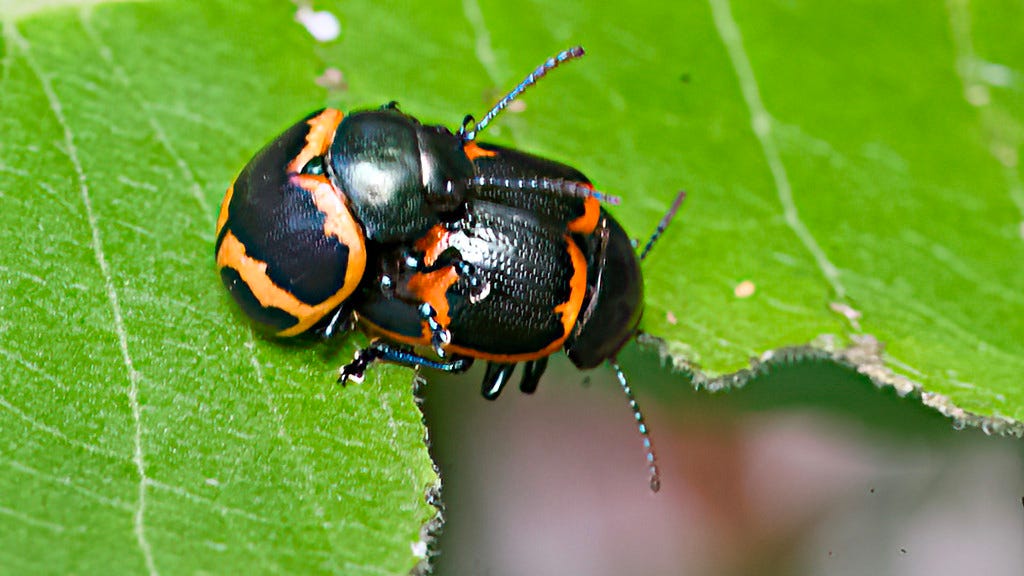
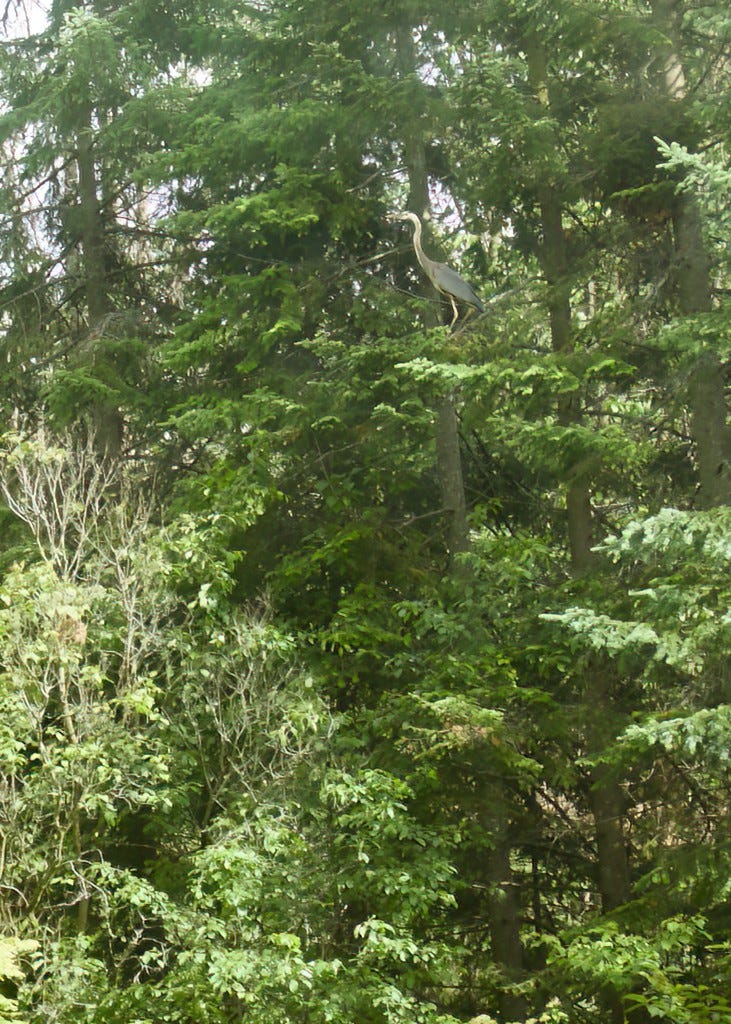


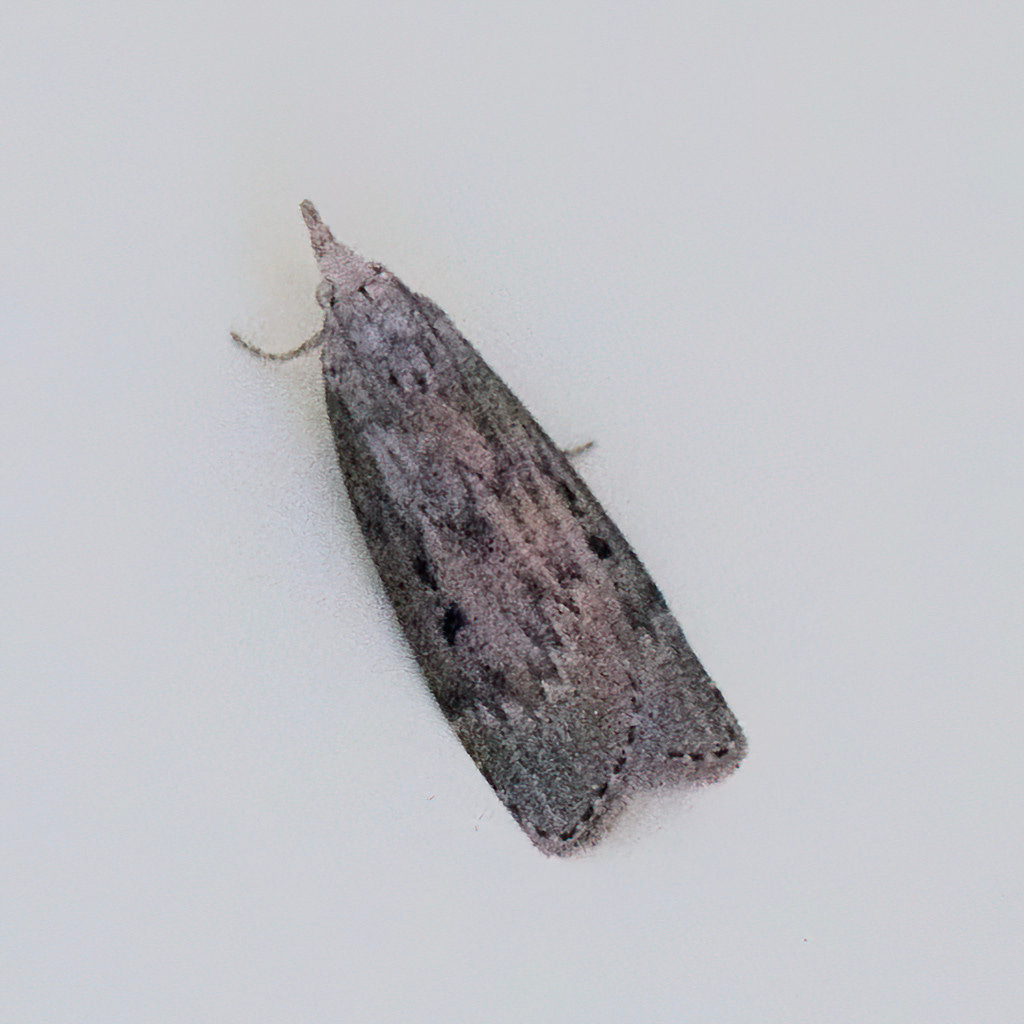

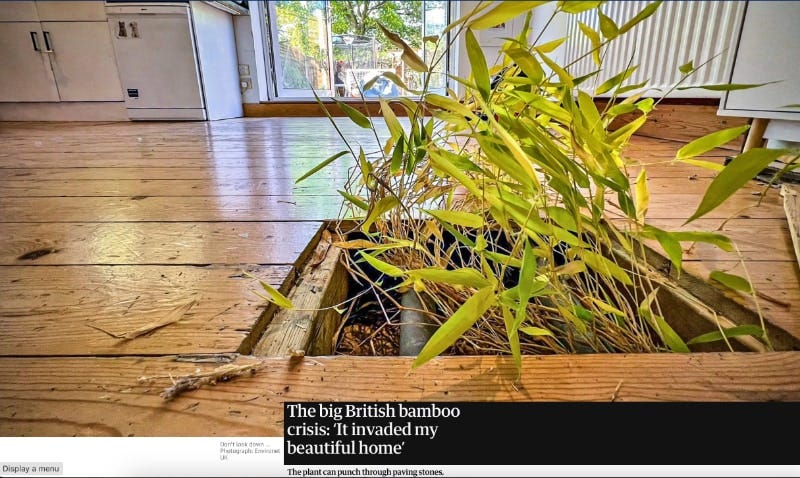
If that was the 9th when you spotted that Heron, perhaps it was looking for some shelter inland as the 8th was a very windy day on the lake. I once saw a heron in my back yard up near Victoria years ago during a very violent summer storm.
Have yet to see a single butterfly here in urban Toronto, let alone a Monarch. Last year, I counted five Monarchs. They are in decline.